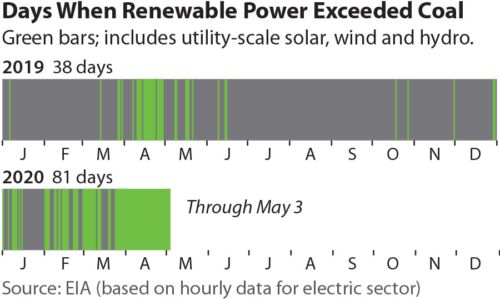
This impressive stretch actually began on March 25, when utility-scale solar, wind and hydropower collectively produced more than coal-fired generation, and has continued for at least 40 straight days through May 3, according to preliminary figures from the EIA’s Hourly Electric Grid Monitor. These figures are even more remarkable when compared to 2019’s total of 38 days when renewables beat coal. Last April had a total of 19 days when this happened—the most of any month in 2019—with the longest continuous stretch lasting just nine days.
The transition away from coal for electricity generation has accelerated in 2020 due to a number of factors, particularly low gas prices, warmer weather, a significant amount of new renewable capacity connecting to the grid late last year, and more recently, lower power demand from the economic slowdown because of the coronavirus.

IEEFA had forecasted that power generation from renewables would likely surpass coal-fired generation in 2021, an important milestone in the energy transition that is well underway.
But in the first quarter of 2020, renewable generation unexpectedly exceeded coal, and with this strong performance continuing in the second quarter, there is an increasing chance that the milestone could occur this year.
Coal’s high cost has made it increasingly one of the last fuel choices for many utilities, a trend reflected by its declining market share for electric generation: just 15.3% in April, according to preliminary EIA figures.
In January, coal’s market share fell below 20 percent for the first time in many decades—and possibly for the first time in the entire history of the U.S. power industry—ending at 19.9%.
EIA figures also show its share continued to erode, falling to 18.3% in February and 17.3% in March. As recently as 2008, coal’s market share was above 50 percent in the months of January, February and March.
Source: IEEFA.org

